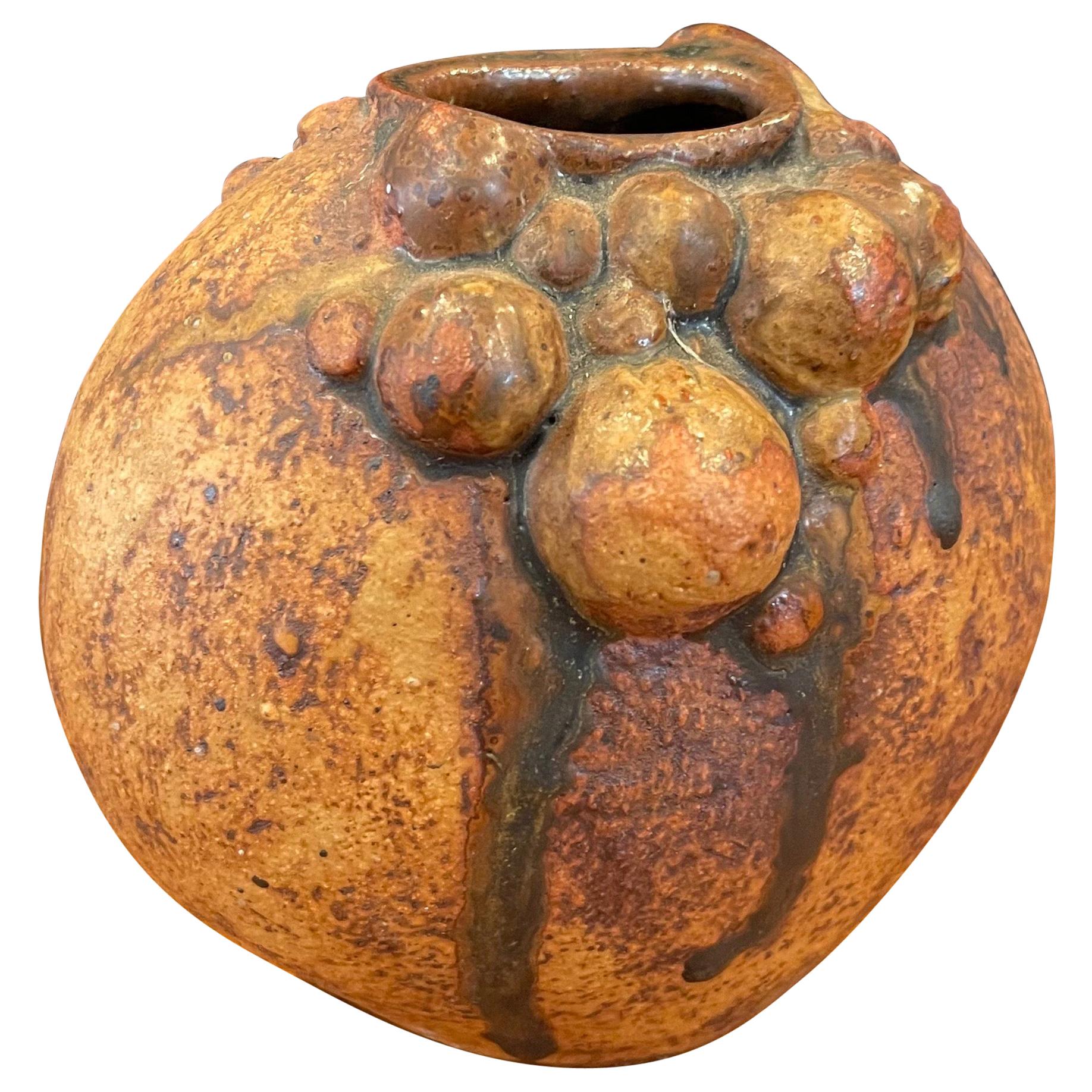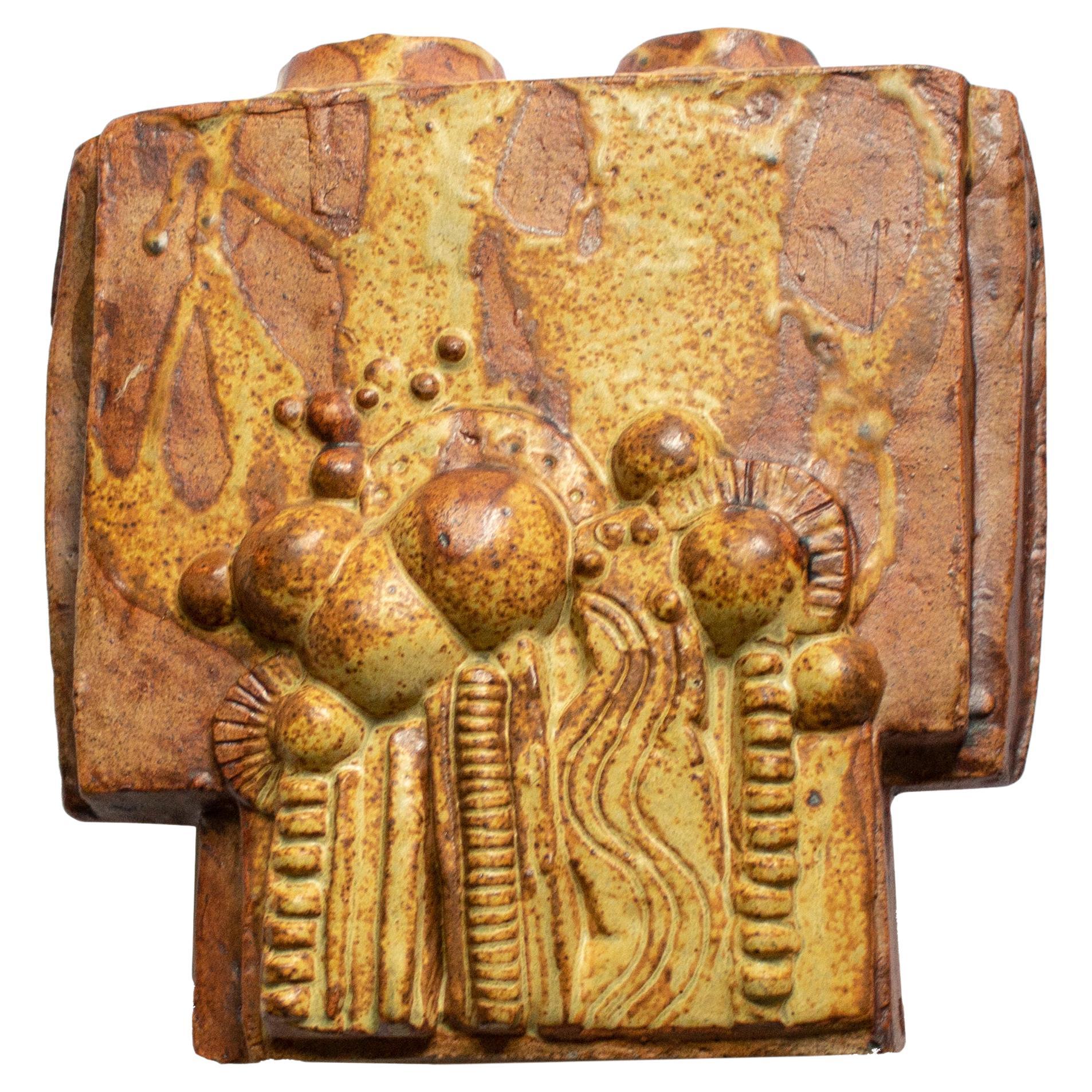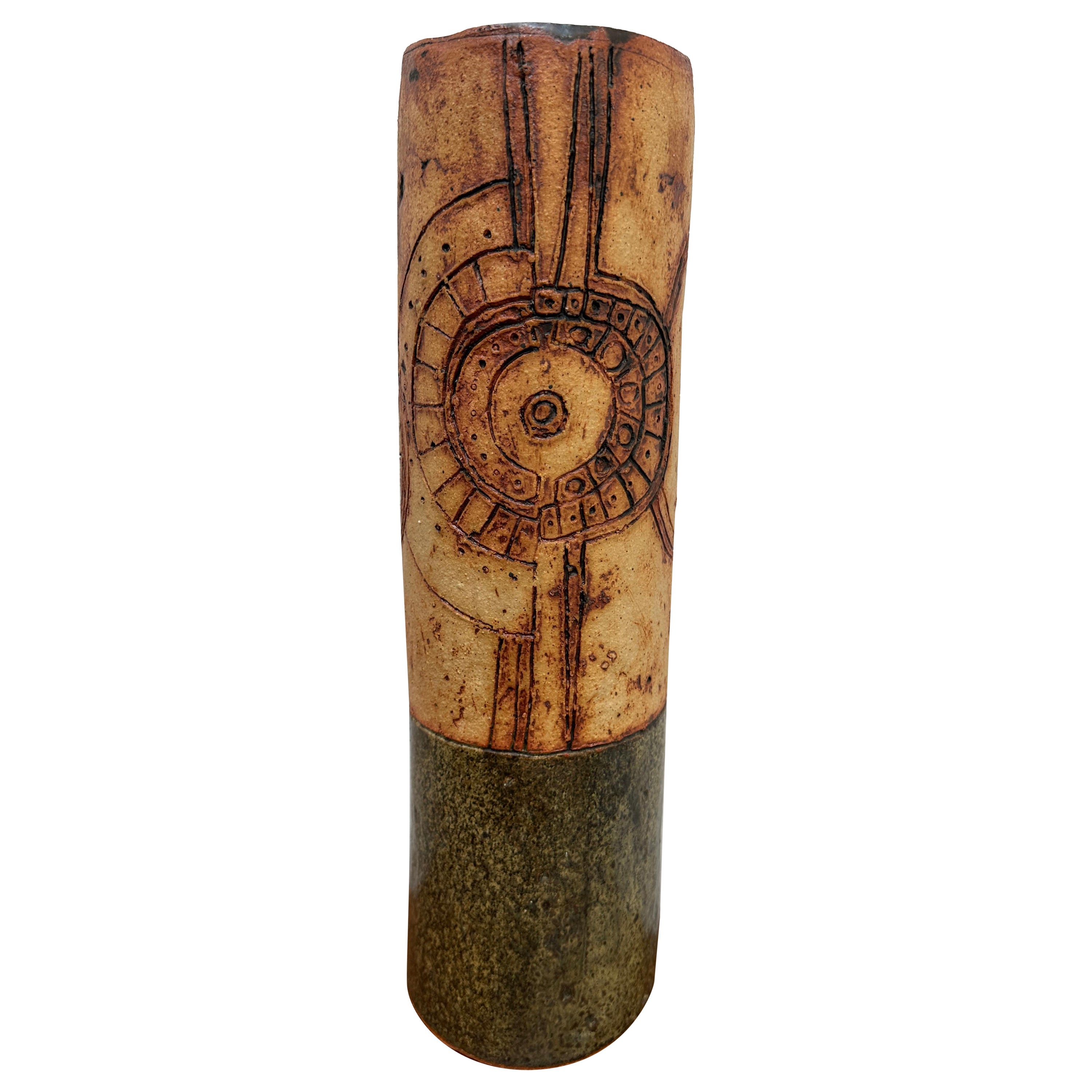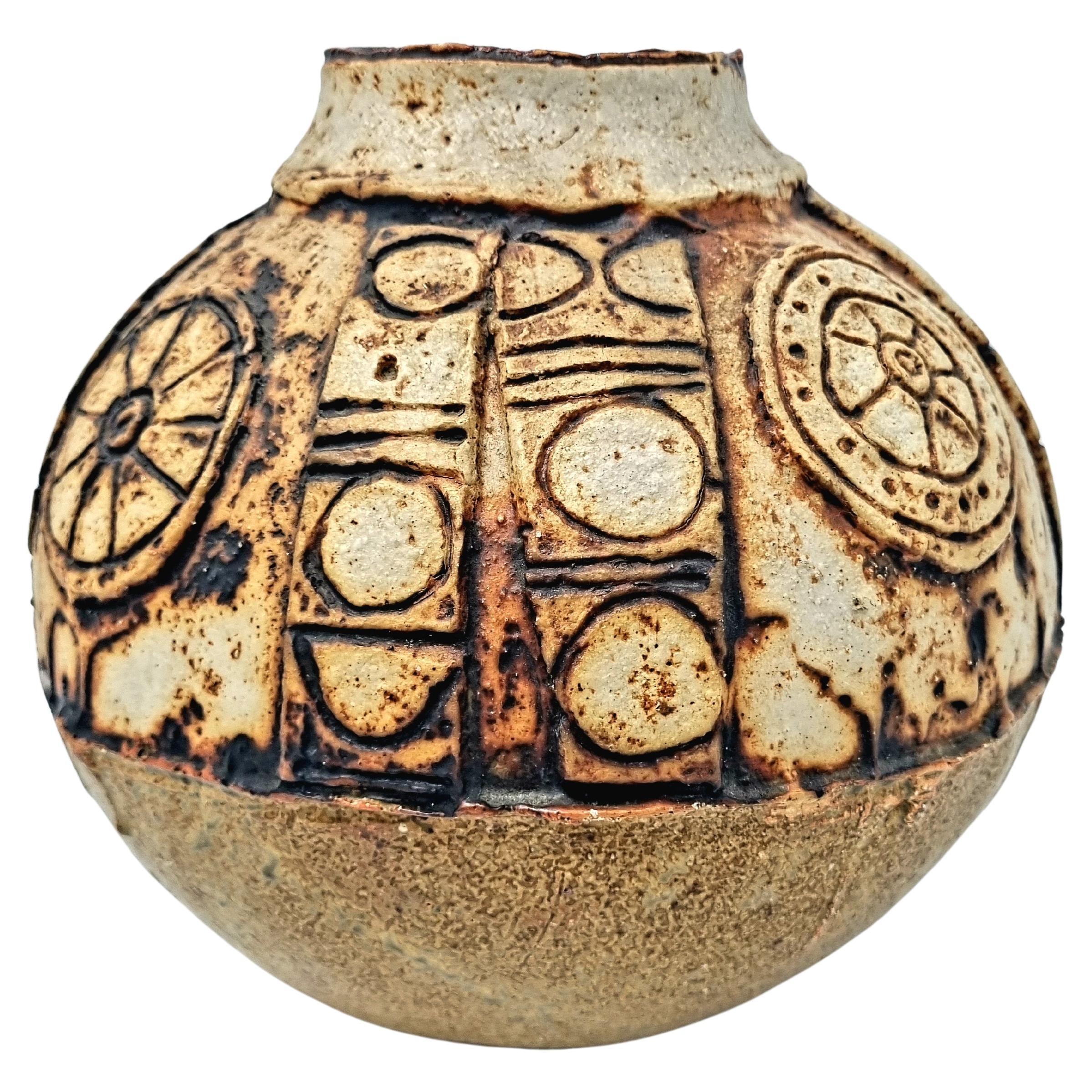Items Similar to Mid-Century Modern Brutalist Ceramic Vase by Bernard Rooke
Want more images or videos?
Request additional images or videos from the seller
1 of 9
Mid-Century Modern Brutalist Ceramic Vase by Bernard Rooke
About the Item
An organic and Brutalist style vase with Medallion motif on front and verso.
Bernard Rooke (born 1938) is a British artist and studio potter. Rooke has exhibited his "Brutalist" ceramics and painting both in the UK and abroad with work in many collections both public and private including the Victoria and Albert Museum, Cleveland Museum of Art, Nuffield Foundation, Röhsska Museum in Sweden and the Trondheim Kunstmuseum in Norway.
Bernard Rooke attended Ipswich School of Art studying painting and lithography before going on to study at Goldsmiths College of Art. It was while studying here that he decided to take up pottery. Although unfamiliar with this craft and tradition, he found that working with clay provided new opportunities for freedom of interpretation and creativity.
In 1960 Rooke set up his first pottery in Forest Hill in South London along with Alan Wallwork. It was a very small room with enough space for a small electric kiln. He was initially using mainly hand building, coiling, blocking and slabbing techniques. While researching ideas, he was supporting himself by part-time lecturing at London University, Goldsmiths College and St Mary's College. In addition, Rooke's membership of 'The Craftsman Potters' Association' enabled him to show his work in a shop in Carnaby Street in London.
In 1967, both the need for a larger working space and becoming disillusioned with living in London spurred Rooke into moving out of the city and to an old mill building in Swilland in Suffolk. Rooke wanted to widen the range of work so as to become more commercial. With the birth of his son, Aaron, and much needed work to be done on the mill, it was important to be able to make a living.
In 1968, the Grand Metropolitan Hotel commissioned Rooke to make 120 standard lamps, 120 table lamps as well as a 24 foot long ceramic mural and another 9 foot high, which incorporated interior lighting. The money from the commission helped to pay for much needed restoration work on the mill.
By the 1970s, a gallery space was opened in the windmill and run by Susan Rooke, Bernard's wife, selling work to locals and tourists as well as to American airmen based nearby. The vision for Mill Gallery was beginning to develop and alongside this a reputation was building bringing in a good source of income.
Sons Aaron and Felix were becoming more involved with the running of the pottery, giving Bernard more time to develop new ideas and designs and more time to continue with his painting. In 2004, the Rooke family decided not to sell to the public through the gallery anymore and close the pottery to concentrate more on painting and printmaking.
In 2017 Bernard's lighting was featured in the Exhibition: “Glass, Light, Paint & Clay” at the Peterborough Museum and Art Gallery. The exhibition featured four artists: Bernard Rooke, John Maltby, Duncan Clarke and Sam Herman selected from the Graham Cooley collection. The catalogue (ISBN 978-1-78808-185-6) features an interview with Bernard in which he describes his life and work.
- Creator:Bernard Rooke (Maker)
- Dimensions:Height: 10.91 in (27.7 cm)Width: 10.24 in (26 cm)Depth: 6.11 in (15.5 cm)
- Style:Brutalist (Of the Period)
- Materials and Techniques:
- Place of Origin:
- Period:
- Date of Manufacture:1960s
- Condition:Mouth of vase width 4.5cm x length 7cm.
- Seller Location:London, GB
- Reference Number:1stDibs: LU2868316368092
About the Seller
5.0
Gold Seller
These expertly vetted sellers are highly rated and consistently exceed customer expectations.
Established in 2015
1stDibs seller since 2017
169 sales on 1stDibs
Typical response time: 1 hour
- ShippingRetrieving quote...Ships From: Maldon, United Kingdom
- Return PolicyA return for this item may be initiated within 14 days of delivery.
More From This SellerView All
- Mid-Century Modern Brutalist Ceramic Table Lamp by Bernard RookeBy Bernard RookeLocated in London, GBAn organic and Brutalist style Butterly table lamp. No chips or cracks. Easily retired for all regions. Bernard Rooke (born 1938) is a British artist and studio potter. Rooke has exhibited his "Brutalist" ceramics and painting both in the UK and abroad with work in many collections both public and private including the Victoria and Albert Museum, Cleveland Museum of Art, Nuffield Foundation, Röhsska Museum in Sweden and the Trondheim Kunstmuseum in Norway. Bernard Rooke attended Ipswich School of Art studying painting and lithography before going on to study at Goldsmiths College of Art. It was while studying here that he decided to take up pottery. Although unfamiliar with this craft and tradition, he found that working with clay provided new opportunities for freedom of interpretation and creativity. In 1960 Rooke set up his first pottery in Forest Hill in South London along with Alan Wallwork. It was a very small room with enough space for a small electric kiln. He was initially using mainly hand building, coiling, blocking and slabbing techniques. While researching ideas, he was supporting himself by part-time lecturing at London University, Goldsmiths College and St Mary's College. In addition, Rooke's membership of 'The Craftsman Potters' Association' enabled him to show his work in a shop in Carnaby Street in London. In 1967, both the need for a larger working space and becoming disillusioned with living in London spurred Rooke into moving out of the city and to an old mill building in Swilland in Suffolk. Rooke wanted to widen the range of work so as to become more commercial. With the birth of his son, Aaron, and much needed work to be done on the mill, it was important to be able to make a living. In 1968, the Grand Metropolitan Hotel commissioned Rooke to make 120 standard lamps, 120 table lamps as well as a 24 foot long ceramic mural and another 9 foot high, which incorporated interior lighting. The money from the commission helped to pay for much needed restoration work on the mill. By the 1970s, a gallery space was opened in the windmill and run by Susan Rooke, Bernard's wife, selling work to locals and tourists as well as to American airmen based nearby. The vision for Mill Gallery was beginning to develop and alongside this a reputation was building bringing in a good source of income. Sons Aaron and Felix were becoming more involved with the running of the pottery, giving Bernard more time to develop new ideas and designs and more time to continue with his painting. In 2004, the Rooke family decided not to sell to the public through the gallery anymore and close the pottery to concentrate more on painting and printmaking. In 2017 Bernard's lighting was featured in the Exhibition: “Glass, Light, Paint & Clay” at the Peterborough Museum and Art Gallery. The exhibition featured four artists: Bernard Rooke, John Maltby...Category
Vintage 1970s English Brutalist Table Lamps
MaterialsClay
- Mid Century Modern Ceramic Jardinière by Bernard RookeBy Bernard RookeLocated in London, GBAn organic and Brutalist style Jardine which would work perfectly with trailing foliage. Bernard Rooke (born 1938) is a British artist and studio potter. Rooke has exhibited his "Brutalist" ceramics and painting both in the UK and abroad with work in many collections both public and private including the Victoria and Albert Museum, Cleveland Museum of Art, Nuffield Foundation, Röhsska Museum in Sweden and the Trondheim Kunstmuseum in Norway. Bernard Rooke attended Ipswich School of Art studying painting and lithography before going on to study at Goldsmiths College of Art. It was while studying here that he decided to take up pottery. Although unfamiliar with this craft and tradition, he found that working with clay provided new opportunities for freedom of interpretation and creativity. In 1960 Rooke set up his first pottery in Forest Hill in South London along with Alan Wallwork. It was a very small room with enough space for a small electric kiln. He was initially using mainly hand building, coiling, blocking and slabbing techniques. While researching ideas, he was supporting himself by part-time lecturing at London University, Goldsmiths College and St Mary's College. In addition, Rooke's membership of 'The Craftsman Potters' Association' enabled him to show his work in a shop in Carnaby Street in London. In 1967, both the need for a larger working space and becoming disillusioned with living in London spurred Rooke into moving out of the city and to an old mill building in Swilland in Suffolk. Rooke wanted to widen the range of work so as to become more commercial. With the birth of his son, Aaron, and much needed work to be done on the mill, it was important to be able to make a living. In 1968, the Grand Metropolitan Hotel commissioned Rooke to make 120 standard lamps, 120 table lamps as well as a 24 foot long ceramic mural and another 9 foot high, which incorporated interior lighting. The money from the commission helped to pay for much needed restoration work on the mill. By the 1970s, a gallery space was opened in the windmill and run by Susan Rooke, Bernard's wife, selling work to locals and tourists as well as to American airmen based nearby. The vision for Mill Gallery was beginning to develop and alongside this a reputation was building bringing in a good source of income. Sons Aaron and Felix were becoming more involved with the running of the pottery, giving Bernard more time to develop new ideas and designs and more time to continue with his painting. In 2004, the Rooke family decided not to sell to the public through the gallery anymore and close the pottery to concentrate more on painting and printmaking. In 2017 Bernard's lighting was featured in the Exhibition: “Glass, Light, Paint & Clay” at the Peterborough Museum and Art Gallery. The exhibition featured four artists: Bernard Rooke, John Maltby...Category
Vintage 1970s English Brutalist Planters and Jardinieres
MaterialsClay
- Bernard Rooke Brutalist Abstract Table Light in Organic Style 1960’s-1970By Bernard RookeLocated in London, GBAn organic and Brutalist style Butterly table lamp. No chips or cracks. Has been professionally rewired and PAT tested. Easily rewired for all regions. Bernard Rooke (born 1938) is a British artist and studio potter. Rooke has exhibited his "Brutalist" ceramics and painting both in the UK and abroad with work in many collections both public and private including the Victoria and Albert Museum, Cleveland Museum of Art, Nuffield Foundation, Röhsska Museum in Sweden and the Trondheim Kunstmuseum in Norway. Bernard Rooke attended Ipswich School of Art studying painting and lithography before going on to study at Goldsmiths College of Art. It was while studying here that he decided to take up pottery. Although unfamiliar with this craft and tradition, he found that working with clay provided new opportunities for freedom of interpretation and creativity. In 1960 Rooke set up his first pottery in Forest Hill in South London along with Alan Wallwork. It was a very small room with enough space for a small electric kiln. He was initially using mainly hand building, coiling, blocking and slabbing techniques. While researching ideas, he was supporting himself by part-time lecturing at London University, Goldsmiths College and St Mary's College. In addition, Rooke's membership of 'The Craftsman Potters' Association' enabled him to show his work in a shop in Carnaby Street in London. In 1967, both the need for a larger working space and becoming disillusioned with living in London spurred Rooke into moving out of the city and to an old mill building in Swilland in Suffolk. Rooke wanted to widen the range of work so as to become more commercial. With the birth of his son, Aaron, and much needed work to be done on the mill, it was important to be able to make a living. In 1968, the Grand Metropolitan Hotel commissioned Rooke to make 120 standard lamps, 120 table lamps as well as a 24 foot long ceramic mural and another 9 foot high, which incorporated interior lighting. The money from the commission helped to pay for much needed restoration work on the mill. By the 1970s, a gallery space was opened in the windmill and run by Susan Rooke, Bernard's wife, selling work to locals and tourists as well as to American airmen based nearby. The vision for Mill Gallery was beginning to develop and alongside this a reputation was building bringing in a good source of income. Sons Aaron and Felix were becoming more involved with the running of the pottery, giving Bernard more time to develop new ideas and designs and more time to continue with his painting. In 2004, the Rooke family decided not to sell to the public through the gallery anymore and close the pottery to concentrate more on painting and printmaking. In 2017 Bernard's lighting was featured in the Exhibition: “Glass, Light, Paint & Clay” at the Peterborough Museum and Art Gallery. The exhibition featured four artists: Bernard Rooke, John Maltby...Category
Vintage 1960s English Brutalist Table Lamps
MaterialsPottery
- Bernard Rooke Brutalist Dragon Fly and Leaf Floor Lamp Organic Style 1960-1970By Bernard RookeLocated in London, GBAn organic and Brutalist style Floor Lamp with Dragon Fly and Leaf design. No chips or cracks. Easily rewired for all regions. Bernard Rooke (born 1938) is a British artist and studio potter. Rooke has exhibited his "Brutalist" ceramics and painting both in the UK and abroad with work in many collections both public and private including the Victoria and Albert Museum, Cleveland Museum of Art, Nuffield Foundation, Röhsska Museum in Sweden and the Trondheim Kunstmuseum in Norway. Bernard Rooke attended Ipswich School of Art studying painting and lithography before going on to study at Goldsmiths College of Art. It was while studying here that he decided to take up pottery. Although unfamiliar with this craft and tradition, he found that working with clay provided new opportunities for freedom of interpretation and creativity. In 1960 Rooke set up his first pottery in Forest Hill in South London along with Alan Wallwork. It was a very small room with enough space for a small electric kiln. He was initially using mainly hand building, coiling, blocking and slabbing techniques. While researching ideas, he was supporting himself by part-time lecturing at London University, Goldsmiths College and St Mary's College. In addition, Rooke's membership of 'The Craftsman Potters' Association' enabled him to show his work in a shop in Carnaby Street in London. In 1967, both the need for a larger working space and becoming disillusioned with living in London spurred Rooke into moving out of the city and to an old mill building in Swilland in Suffolk. Rooke wanted to widen the range of work so as to become more commercial. With the birth of his son, Aaron, and much needed work to be done on the mill, it was important to be able to make a living. In 1968, the Grand Metropolitan Hotel commissioned Rooke to make 120 standard lamps, 120 table lamps as well as a 24 foot long ceramic mural and another 9 foot high, which incorporated interior lighting. The money from the commission helped to pay for much needed restoration work on the mill. By the 1970s, a gallery space was opened in the windmill and run by Susan Rooke, Bernard's wife, selling work to locals and tourists as well as to American airmen based nearby. The vision for Mill Gallery was beginning to develop and alongside this a reputation was building bringing in a good source of income. Sons Aaron and Felix were becoming more involved with the running of the pottery, giving Bernard more time to develop new ideas and designs and more time to continue with his painting. In 2004, the Rooke family decided not to sell to the public through the gallery anymore and close the pottery to concentrate more on painting and printmaking. In 2017 Bernard's lighting was featured in the Exhibition: “Glass, Light, Paint & Clay” at the Peterborough Museum and Art Gallery. The exhibition featured four artists: Bernard Rooke, John Maltby...Category
Vintage 1960s English Brutalist Floor Lamps
MaterialsPottery
- Mid-Century Modern Brutalist Pendant Light by Svend Aage Holm Sørensen, 1960’sBy Svend Aage Holm Sørensen, Holm SørensenLocated in London, GBDanish designer Svend Aage Holm Sørensen (1913-2004) is known for his self-produced lighting designs dating from the 1950s, ‘60s and ‘70s. Despite the desirability of his designs on the vintage market, there is a lack of biographical information on the designer and his eponymous manufacturing company. The Danish designer Svend Aage Holm-Sørensen (1913-2004) possessed an artist eye and a very good understanding of the potential of materials, and he understood how to innovate with these. To this day, Holm-Sørensen's style as a designer addresses not only the Nordic market, but also the international interest in the designer's distinctive and experimental expression. Sven Aage was known for being able to draw sketches on almost everything: envelopes, theater programs, even tram tickets he used to sketch his vision. It is speculated that Holm Sørensen designed lights for well-known Danish lighting manufacturers Fog & Mørup and Lyfa in the 1950s, before establishing his own lighting company, Holm Sørensen A/S to produce and distribute his own designs. Holm Sørensen’s style varies greatly, with designs from the 1950s truly reflecting the mid-century modern lighting style, with clear influences from the De Stijl and Bauhaus movements. His attenuated floor and table lamps contain the classic tri-pod base that was popular at the time, referencing such designs as H. Th. J. A. Busquet’s Pinocchio Lamp (1954). From the 1960s onwards, Holm Sørensen’s style changed utterly. His designs diverged from colorful, geometric table lamps and floor lamps, to pendants with raw finished brass and copper surfaces. These pendant lamps showcase Holm Sørensen’s interpretation of the Brutalist style, which was popular from the 1950s to the mid-70s. Originally coined by the Swedish architect Hans Asplund...Category
Vintage 1960s Danish Brutalist Chandeliers and Pendants
MaterialsBrass
- Scandinavian Modern Pair of Heart Shaped Holmegaard Vases by Per LutkenBy Holmegaard, Per Lutken for HolmegaardLocated in London, GBA pair of Danish Mid-Century Modern heart shaped vases in light blue hand blown art glass. Both vases are intact and in beautiful colour and bright condition. By designer and artisti...Category
Vintage 1960s Danish Scandinavian Modern Vases
MaterialsBlown Glass
You May Also Like
- Bernard Rooke Studio Pottery / Brutalist Vase C. 1960sBy Bernard RookeLocated in Hoddesdon, GBBernard Rooke Studio Pottery Chalice is a rare vintage example from the 1960s. Made by the renowned British artist and potter, Bernard Rooke, this piece is a true testament to his ar...Category
Vintage 1960s British Brutalist Vases
MaterialsPottery
- Brutalist Earthenware Pottery Vase by Bernard RookeBy Bernard RookeLocated in San Diego, CAA very nice Brutalist earthenware pottery vase by Bernard Rooke, circa 1970s. The piece is in very good vintage condition with no chips, cracks or crazing and measures 5.5" W x 4" D ...Category
Mid-20th Century American Mid-Century Modern Vases
MaterialsEarthenware
- Brutalist Ceramic Vase by Bernard Rooke, England, 1970s, SignedBy Bernard Rooke StudioLocated in Stockholm, SEBrutalist ceramic vase by Bernard Rooke, England, 1970s. In 1960 he set up his own workshop in Forest Hill, London. Progressive designs were rea...Category
Vintage 1970s English Brutalist Vases
MaterialsStoneware, Ceramic
- 1960s Brutalist British Bernard Rooke Cylindrical Abstract Glazed Pottery VaseBy Bernard Rooke, Bernard Rooke StudioLocated in London, GBA large 1960s vintage Studio Pottery early brutalist cylindrical ceramic vase by British ceramicist Bernard Rooke. The upper two-thirds features an incised abstract design which is ...Category
Mid-20th Century British Brutalist Vases
MaterialsCeramic, Pottery
- Ceramic Vessel by Bernard Rooke, Mid-20th Century, EnglandBy Bernard RookeLocated in London, GBMid-20th century ceramic vessel in neutral tones, by British artist Bernard Rooke. The vessel has a trapezoidal shape decorated with hieroglyphics front and back, and glazed to the ...Category
20th Century British Mid-Century Modern Vases
MaterialsCeramic
- Bernard Rooke Studio Pottery / Vase Circa 1960sBy Bernard RookeLocated in Hoddesdon, GBBernard Rooke Studio Pottery vase . A rare vintage 1960s example. Made by the renowned British artist, potter, Bernard Rooke, this piece is a wonderful example of his work . Be...Category
Vintage 1960s British Brutalist Vases
MaterialsPottery
Recently Viewed
View AllMore Ways To Browse
Uk Mid Century Modern
Large Mid Century Modern Vase
Large Vase Midcentury Modern
Small Mid Century Vases
Clay Mid Century Modern
Mid Century Modern Large Glass Vases
Mid Century Vase Collection
Midcentury Large Ceramic Vase
Mid Century Vessel Vase Set
Modern Vase London
Mid Century Bathroom Light
Vintage Clay Vessel
Modern Hill Mid Century
New Brutalist
Small Brutalist
Retro Clay Vase
Vase Uk
Old Vintage Vases





